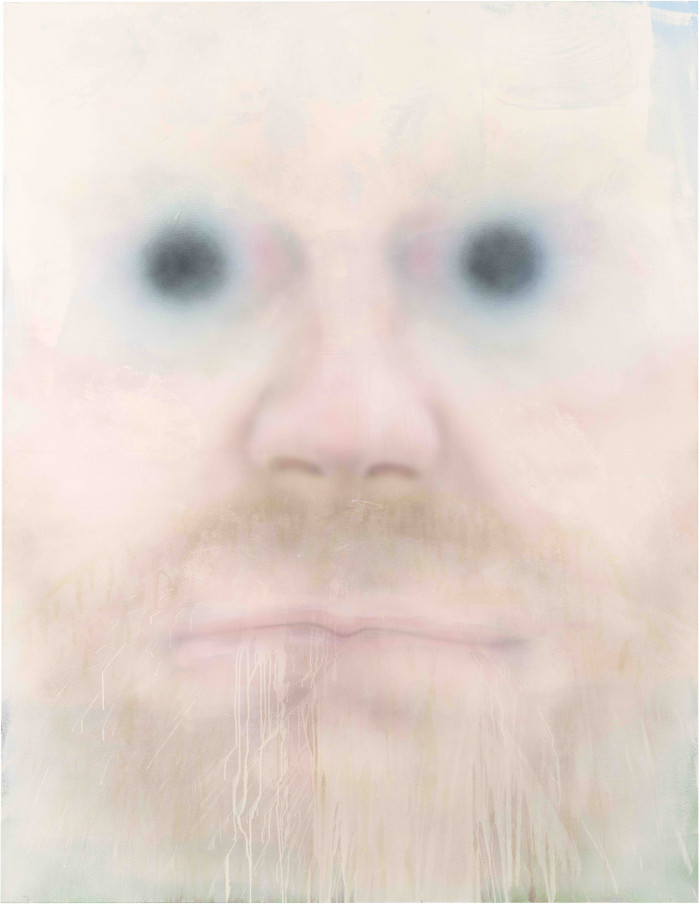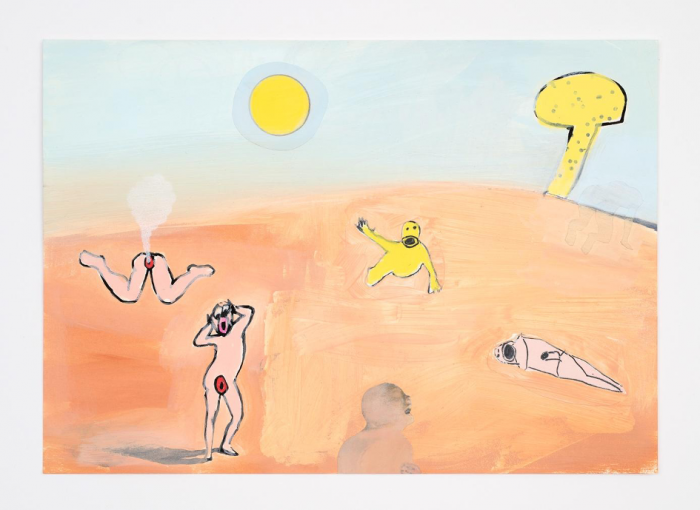Song of the Whale
Song of the Whale was first exhibited during the Planétarium exhibition at Sorry We're Closed in 2023. The change from vertical to horizontal defined the new works presented by the artist at the exhibition. "Though it’s an elementary manipulation, it allows other relationships among the characters. In general, I like to set myself challenges, such as those related to the medium, by limiting the colours of a painting, for example." [Bechet, 2023]
Referring to the landscape format, each canvas evolves into a "world painting". A "pictorial adventure, a static journey in a mental landscape" [Sorry We're Closed, Press Release, 2023]. These large mental panoramas, half abstract and half dramatic, are enigmatic, minimalist, graphic and metaphysical at the same time. Various shapes and motifs are floating above backgrounds of bright or pastel colours in these immersive synthetic scenes. The instinctive and spontaneous association of recurring motifs and new elements generates a seemingly naive style of its own. Yet self-representation, which is always pivotal in Meert's work, is still highly present and forms as many variations of his self-portraits. In the same painting, stars and comets are shown, scribbled silhouettes and realistic self-portraits, simple flat colour tones and more detailed motifs, flower pots and robots.
"The spontaneity of the recreational drawings now manifests itself in an unrestrained style that, sometimes on the same canvas, freely combines bright lines with sharply cut surfaces derived from drawing collages or cartoons. Some paintings are skeletal and unadorned, focusing on a few figures, whereas others are loud and colourful, and are prolonged reworkings. Recognisable subjects dissolve or disappear here and there, leading to indeterminate forms that flirt with the Colour Field and abstract landscapes with an unfinished look. The chromatic palette is equally versatile, with pastels, sharp or fluorescent colours, yet always intense [...]. Delicate gradations, fading harmoniously, are shamelessly overrun by uncontrolled drops. [...] Julien Meert breaks all boundaries and explores the limits of anything unfamiliar. He no longer denies himself anything, not even the use of stencils, which he had long considered a tool of poor street art, and which have now become a defining instrument in his new work. [...] His pictorial dramaturgy is alternately droll (and casually also mock the artist's egotistical character), tragic, romantic or dreamy." [Caltagirone, 2023].
However, as in his entire oeuvre, this childlike appearance covers inner conflicts or agonising metaphysical questions.
While painting, the artist is unable to control all the elements that end up on his canvas. His gestures are instinctive and spontaneous, as if hastily executed, followed by the (psychoanalytic) interpretation only later on, in a conversation on the night of the vernissage or many years later.
Song of the Whale is identified by a dominant orange-pink hue. The soft peach colour covers the entire canvas and is reminiscent of a stroll. A tender ramble, like the couple enviously watched from the right, embracing each other under the snow in the centre of the canvas. Inspired by Belgian painter Gustave De Smet (1877-1943), these two figures, one of whom is masked, provide both a reassuring and a distressing depiction of a couple. The artist effectively alludes to the intimacy of the couple. By anonymising one of the two, Meert points out that, in the end, the focus is less on the other than on yourself.
The title is derived from the shape just below the horizon line, which provides structure to the composition. This detail could appear to be a phallic shape, or it could be the tail of a whale. While working on this canvas, Meert frequently listened to Song of the Whale, composed in 1981 by an old Texas synthesiser specialist, J.D. Emmanuel. Few of Meert's works have a title. Any works that do have a title are always references to musical works.
In this powdered universe, reminiscent of boudoir interiors, some elements, such as theatrical mirrors, are combined with coarser images, such as the two male figures in the bottom corners, borrowed directly from the sculpted heads of American artist Nancy Grossman, which refers to the artist's complex relationship with masculinity. One of them appears to be licking the artist's disgusted face, stencilled in the bottom left corner.
Painted in winter, the motif of snow falling down around the couple paradoxically contrasts with the warm tones. In this tension between inside and outside, the motif of the cat at the top symbolises the inside. The artist has immortalised that cat while letting out a breeze. On the occasion of the exhibition at the Planétarium, the artist published a book entirely dedicated to Météorismes. This light and familiar figure plays a compensating role in relation to the underlying uneasiness exuded by the entire composition. In conclusion, some blue areas - the same absolute blue present in almost all his canvases - leave the previous layers of paint visible, emphasising the artist's layered working process.



